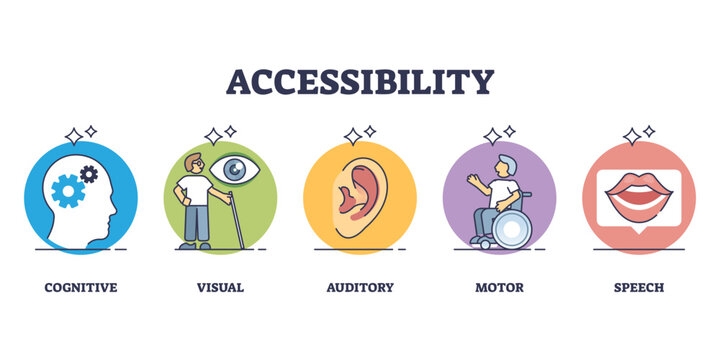Upgrading Accessibility: Modern Innovations in Disabled Symbol Signage

Accessibility is a crucial aspect of modern infrastructure, ensuring that individuals with disabilities can navigate public spaces with ease and dignity. One of the most recognizable elements of accessibility is disabled symbol signage. Traditionally, the International Symbol of Access (ISA) — the familiar wheelchair icon — has been the standard for identifying accessible spaces. However, with evolving perspectives on disability and inclusivity, new and innovative signage designs are emerging to better represent the diverse abilities and mobility needs of individuals.
In this blog post, we explore the modern innovations in Disability Access Symbols signage, their impact on inclusivity, and how businesses and organizations can upgrade their accessibility standards.
The Evolution of Disabled Symbol Signage
The ISA, introduced in 1968, has been a universal representation of accessibility. While effective in its purpose, it has faced criticism for being static and outdated, reinforcing outdated perceptions of disability.
Newer designs, such as the Dynamic Accessibility Symbol, feature a more active and forward-leaning figure, emphasizing movement and independence. This modern approach shifts the narrative from disability being passive to empowering individuals with disabilities as active members of society.
Key Innovations in Disabled Symbol Signage
1. Dynamic Accessibility Symbol
One of the most significant innovations in accessibility signage is the Dynamic Accessibility Symbol. Developed by the Accessible Icon Project, this symbol depicts a wheelchair user in motion, highlighting independence and capability. Many states and countries have begun adopting this symbol as a replacement for the traditional ISA, making accessibility signage more progressive and inclusive.
2. Customizable and Inclusive Icons
With advancements in design, many organizations are creating customizable accessibility symbols to represent a broader spectrum of disabilities. These include signage for individuals with invisible disabilities, hearing impairments, cognitive disabilities, and neurodivergent conditions. By integrating symbols that reflect different needs, public spaces become more inclusive and accommodating.
3. Digital and Smart Signage
Technology has transformed accessibility signage beyond static visuals. Digital and smart signs now offer:
-
Voice-assisted navigation for visually impaired individuals
-
QR codes linking to accessibility information
-
Interactive screens that provide multi-sensory guidance
-
Augmented reality (AR) features to enhance navigation These innovations ensure that accessibility extends beyond physical markers, offering real-time assistance to individuals who need it.
4. High-Contrast and Tactile Signage
For individuals with visual impairments, high-contrast colors and Braille integration are essential. Modern accessibility signage incorporates bold color contrasts, large fonts, and embossed elements to improve readability for individuals with low vision. Tactile signs, including raised symbols and letters, help blind individuals navigate spaces more effectively.
5. Wayfinding Systems with Universal Design
Wayfinding systems, such as those found in airports, hospitals, and malls, are incorporating universal design principles to enhance accessibility. These systems integrate:
-
Multi-sensory cues (visual, auditory, and tactile feedback)
-
Digital maps with accessibility filters
-
Clear and easy-to-read symbols By ensuring that signage is universally designed, individuals with disabilities can navigate spaces independently and confidently.
The Impact of Modern Accessibility Signage
Innovative accessibility signage has a profound impact on inclusivity. By upgrading outdated symbols and implementing technology-driven solutions, public and private spaces become more accommodating to diverse individuals. The key benefits include:
-
Enhanced dignity and empowerment: New symbols promote a more respectful and empowering representation of individuals with disabilities.
-
Increased independence: Smart and interactive signage reduces reliance on assistance, allowing individuals to navigate spaces independently.
-
Improved public perception: Businesses and institutions that adopt modern accessibility signage demonstrate a commitment to diversity and inclusion, fostering positive brand perception.
-
Legal compliance and social responsibility: Many regions are updating accessibility laws, requiring businesses to upgrade their signage to meet new standards.
How Businesses and Organizations Can Upgrade Accessibility Signage
If you’re looking to enhance accessibility within your business or organization, consider the following steps:
-
Evaluate Existing Signage: Assess whether your current signs are outdated and inclusive of all disabilities.
-
Adopt Modern Symbols: Replace traditional ISA signs with dynamic and more inclusive accessibility symbols.
-
Integrate Technology: Utilize digital signage and interactive elements to assist individuals with disabilities.
-
Ensure Compliance: Stay updated with legal requirements and guidelines for accessibility signage in your region.
-
Consult Accessibility Experts: Work with disability advocacy groups and design experts to create signage that meets diverse needs.
Conclusion
As society progresses toward greater inclusivity, upgrading accessibility signage is a small yet impactful step toward a more equitable world. By embracing modern innovations in disabled symbol signage, businesses, public institutions, and policymakers can foster an environment that respects and empowers individuals with disabilities. Whether through the adoption of the Dynamic Accessibility Solution, smart signage, or tactile elements, these upgrades contribute to a more accessible and inclusive society for all.
If you’re looking to upgrade your accessibility signage, now is the time to take action. Embracing these changes not only benefits individuals with disabilities but also creates a more inclusive space for everyone.
- Questions and Answers
- Opinion
- Motivational and Inspiring Story
- Technology
- Live and Let live
- Focus
- Geopolitics
- Military-Arms/Equipment
- الحماية
- Economy
- Beasts of Nations
- Machine Tools-The “Mother Industry”
- Art
- Causes
- Crafts
- Dance
- Drinks
- Film/Movie
- Fitness
- Food
- الألعاب
- Gardening
- Health
- الرئيسية
- Literature
- Music
- Networking
- أخرى
- Party
- Religion
- Shopping
- Sports
- Theater
- Health and Wellness
- News
- Culture

